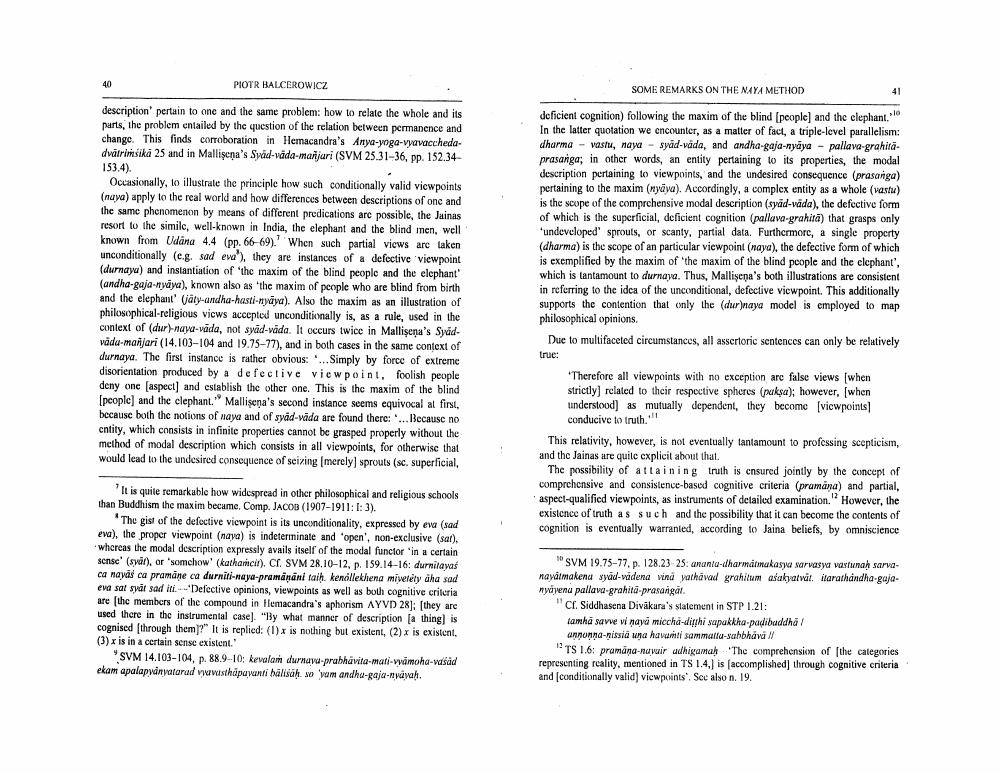Book Title: Some Remarks On The Naya Mmethod Author(s): Piotr Balcerowicz Publisher: Piotr Balcerowicz View full book textPage 3
________________ PIOTR BALCEROWICZ description' pertain to one and the same problem: how to relate the whole and its parts, the problem entailed by the question of the relation between permanence and change. This finds corroboration in Hemacandra's Anya-yoga-vyavacchedadvātrimšikā 25 and in Mallişena's Syad-vada-manjari (SVM 25.31-36, pp. 152.34153.4). 40 Occasionally, to illustrate the principle how such conditionally valid viewpoints (naya) apply to the real world and how differences between descriptions of one and the same phenomenon by means of different predications are possible, the Jainas resort to the simile, well-known in India, the elephant and the blind men, well known from Udana 4.4 (pp. 66-69). When such partial views are taken unconditionally (e.g. sad eva"), they are instances of a defective viewpoint (durnaya) and instantiation of 'the maxim of the blind people and the elephant" (andha-gaja-nyaya), known also as 'the maxim of people who are blind from birth and the elephant' (jäty-andha-hasti-nyaya). Also the maxim as an illustration of philosophical-religious views accepted unconditionally is, as a rule, used in the context of (dur)-naya-vada, not syad-väda. It occurs twice in Mallisena's Syadvädu-mañjarī (14.103-104 and 19.75-77), and in both cases in the same context of durnaya. The first instance is rather obvious: ... Simply by force of extreme disorientation produced by a defective viewpoint, foolish people deny one [aspect] and establish the other one. This is the maxim of the blind [people] and the clephant." Mallişena's second instance seems equivocal at first, because both the notions of naya and of syäd-vada are found there: ... Because no entity, which consists in infinite properties cannot be grasped properly without the method of modal description which consists in all viewpoints, for otherwise that would lead to the undesired consequence of seizing [merely] sprouts (sc. superficial, "It is quite remarkable how widespread in other philosophical and religious schools than Buddhism the maxim became. Comp. JACOB (1907-1911: I: 3). The gist of the defective viewpoint is its unconditionality, expressed by eva (sad eva), the proper viewpoint (naya) is indeterminate and 'open', non-exclusive (sat). whereas the modal description expressly avails itself of the modal functor in a certain sense' (syr), or 'somehow' (kathamcit). Cf. SVM 28.10-12, p. 159.14-16: durnitayas ca nayaś ca pramane ca durniti-naya-pramänäni taiḥ, kenöllekhena mivetéty äha sad eva sat syat sad iti.'Defective opinions, viewpoints as well as both cognitive criteria are (the members of the compound in Hemacandra's aphorism AYVD 28]; [they are used there in the instrumental case]. "By what manner of description [a thing] is cognised [through them]?" It is replied: (1) x is nothing but existent, (2) x is existent, (3) x is in a certain sense existent." "SVM 14.103-104, p. 88.9-10: kevalam durnaya-prabhävita-mati-vyamoha-vasäd ekam apalapyanyatarad vyavasthapayanti bälisäḥ so 'yam andhu-gaja-nyayah. SOME REMARKS ON THE NAYA METHOD deficient cognition) following the maxim of the blind [people] and the elephant."" In the latter quotation we encounter, as a matter of fact, a triple-level parallelism: dharma vastu, naya syad-vada, and andha-gaja-nyaya - pallava-grahitäprasanga; in other words, an entity pertaining to its properties, the modal description pertaining to viewpoints, and the undesired consequence (prasanga) pertaining to the maxim (nyaya). Accordingly, a complex entity as a whole (vastu) is the scope of the comprehensive modal description (syad-vada), the defective form of which is the superficial, deficient cognition (pallava-grahita) that grasps only 'undeveloped sprouts, or scanty, partial data. Furthermore, a single property (dharma) is the scope of an particular viewpoint (naya), the defective form of which is exemplified by the maxim of 'the maxim of the blind people and the elephant", which is tantamount to durnaya. Thus, Mallişena's both illustrations are consistent in referring to the idea of the unconditional, defective viewpoint. This additionally supports the contention that only the (dur)naya model is employed to map philosophical opinions. 41 Due to multifaceted circumstances, all assertoric sentences can only be relatively true: 'Therefore all viewpoints with no exception are false views [when strictly] related to their respective spheres (paksa); however, [when understood] as mutually dependent, they become [viewpoints] conducive to truth. This relativity, however, is not eventually tantamount to professing scepticism, and the Jainas are quite explicit about that. The possibility of attaining truth is ensured jointly by the concept of comprehensive and consistence-based cognitive criteria (pramana) and partial, aspect-qualified viewpoints, as instruments of detailed examination. However, the existence of truth as such and the possibility that it can become the contents of cognition is eventually warranted, according to Jaina beliefs, by omniscience. SVM 19.75-77, p. 128.23 25: ananta-dharmatmakasya sarvasya vastunaḥ sarvanayatmakena syad-vadena vina yathävad grahitum asakyatvät. itarathandha-gajanyayena pallava-grahita-prasangat. 11 Cf. Siddhasena Diväkara's statement in STP 1.21: tamha savve vi naya miccha-dithi sapakkha-padibuddha! annonṇa-nissia una havamti sammalla-sabbhāvā !! 12 TS 1.6: pramāṇa-nayair adhigamah 'The comprehension of [the categories representing reality, mentioned in TS 1.4,] is [accomplished] through cognitive criteria and [conditionally valid] viewpoints. See also n. 19.Page Navigation
1 2 3 4 5 6 7 8 9 10 11 12 13 14 15 16 17
